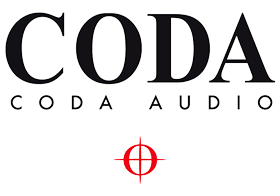Technology
CODA is able to provide superior sonic performance while remaining small, compact, lightweight, and convenient.
How? Through our unique range of patented and innovative technologies.
DDP Technology
CODA’s patented Dual Diaphragm Planar Wave Driver is at the heart of the AiRAY, CiRAY, and ViRAY line array systems and allows these compact speakers to handle high-power applications with low distortion, plus providing exceptional dynamics and frequency response.
Discarding the traditional dome diaphragm compression driver design, CODA Audio utilises a two-way coaxial system employing two concentric annular ring diaphragms. Each diaphragm covers a smaller frequency range resulting in many advantages:
Fidelity: Dramatically reduced inter-modulation distortion
Unlike dome diaphragms, annular ring diaphragms feature wings that are smaller than the wavelengths they reproduce. The diaphragms move in phase, creating far less audible and measurable intermodulation distortion than speakers equipped with traditional drivers, especially at high frequencies.

Frequency Range: 400 Hz to 22 KHz
The outer wings of planar ring diaphragms extend the radius of the diaphragm when compared to traditional compression drivers of equal voice coil size. This greater surface area allows for a lower crossover point and more consistent overall directivity.
Sensitivity: Up to 5dB greater.
CODA DDP wave drivers are far more efficient than traditional compression wave drivers. They boast 3–5 dB higher sensitivity than the top quality conventional alternatives. The low-profile annular ring diaphragms have a double surround supporting a reduced moving mass resulting in a much stiffer and far more efficient transducer with no breakup modes.
DS-FIR Filters: Phase linearity down to 60 Hz
Our advanced FIR multisampling uses a combination of proprietary filters, creating incredible fidelity throughout its operating range. Each is set to a length that is precisely tailored to the virtual and acoustical crossover points.
CODA’s FIR filters ensure pinpoint accuracy and unrivalled phase linearity down to 60Hz, helping to provide distortion-free sound reproduction, perfectly-optimised in the time domain.

Impulse response, phase response, and frequency response graphs of AiRAY system. AiRAY (magenta), SC2-F (blue), and SCP-F (green). Sum trace is shown in red. Measurements taken in an arena 30 m from the system, with no processing applied.
Sensor Control: Providing much lower distortion and total control
More control of the low end with no more distortion in your bass frequencies. Any distortion produced by the driver or the enclosure is instantly corrected to provide accurate bass using high-powered CODA subwoofers. Many subs suffer with non-linear distortion produced by the subwoofer itself, especially under high power conditions.
CODA’s subwoofers and low frequency extensions have been designed to overcome this problem. The transducers in CODA’s sensor controlled low frequency elements contain an integrated velocity sensor that measures LF diaphragm movement in real time and compares it with the audio input signal. This proprietary sensor controlled technology is a self optimising, closed feedback loop that precisely determines how much power the driver needs to accurately reproduce the original audio signal.

Couplers
Couplers used in the VCA family solve a common problem for line arrays.
A typical narrowing of coverage between 150 and 1000 Hz (Fig. 5) is the main reason users count on a “90 degree” line array for much less than its specifications, leading to extra outfills being specified.
All drivers in CODA line arrays are loaded to a Coupler. This design combines the energy produced and allows the element to perform as a single source without phase destruction, achieving a coherent and uniform wavefront (Fig. 3). The Coupler design also determines the horizontal on-axis and off-axis frequency response (Fig. 6).

Fig. 3. CODA Coupler behaves as a single waveguide, producing a unified wavefront without diffraction
AiRAY, CiRAY, and ViRAY contain unique coupler technology that solves the narrowing of coverage that so many loudspeakers struggle with.
Once again, CODA provides unrivalled control with its line array systems.

Fig. 4. CiRAY dispersment angles

Fig. 5. Frequency response of a typical 90º line array system comprising of 12 enclosures. Upper trace is measured on axis; lower trace is measured 30º off axis

Fig. 6. Frequency response of a CODA line array system comprising of 12 enclosures with Coupler technology Upper trace is measured
Instafit Magnetic Couplers*
With CiRAYs Instafit Magnet Couplers, the dispersion pattern can be interchanged quickly and without specialist tools to achieve various horizontal dispersions – narrow, wide, and asymmetric.
CiRAY’s Instafit couplers give you control over horizontal directivity and with the magnetic design, you can make your desired changes with ease.
*Available on CiRAY


Dynamic Airflow Cooling (DAC)
DAC technology found in CiRAY means an incredible level of power can be provided from smaller enclosures thanks to better airflow and dissipation. DAC can double the power handling and SPL compared to a conventionally cooled system.
This technology uses thermal induction by utilising a single-piece aluminium construction that preserves the sound. Putting an immense amount of power into a speaker cabinet required a new design and a new thermal concept: the front baffle and vents are made from aluminium with all drivers mounted into it. These aluminium vents are optimised to maximise airflow, increasing the thermal capacity of the system. Applying more power increases the airflow in the vents, conducting more heat away from the drivers, and distributing that heat outside the enclosure.


